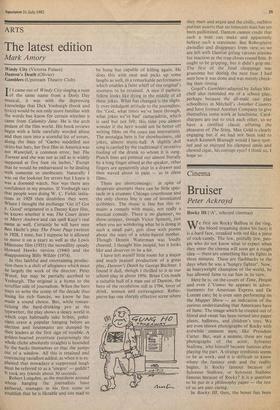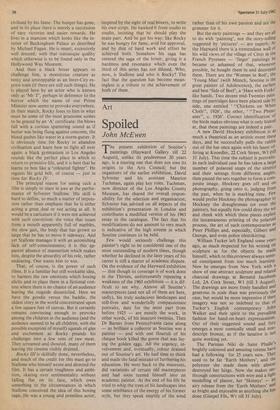Cinema
Bruiser
Peter Ackroyd
Rocky III ('A', selected cinemas)
Wefirst see Rocky Balboa in the ring, the blood streaming down his face; it is a hard face, streaked with red like a piece of rock-candy. The few, pitifully few, peo- ple who do not know what to expect when they enter the cinema will soon get a rough idea — there are something like six fights in three minutes. These are flashbacks to the days when he was a 'hungry fighter'. Now, as heavyweight champion of the world, he has allowed fame to eat him in its turn.
Here he is, on the covers of Time, People and even L'Uomo; he appears in adver- tisements for American Express and De Lorean cars; he is even seen performing on the Muppet Show — an indication of the curious understanding that Americans have of fame. The image which he created out of blood and sweat has been turned into paper plates, balloons, and children's toys. We are even shown photographs of Rocky with erstwhile eminent men, like President Carter. But, wait a minute, these are real photographs of the actor, Sylvester Stallone, who himself became famous after playing the part. A strange symbiosis seems to be at work, and it is difficult to know where the fantasy- ends and the reality begins. Is Rocky famous because of Sylvester Stallone, or Sylvester Stallone famous because of Rocky? It is a question to be put in a philosophy paper — the rest of us are past caring.
In Rocky III, then, the boxer has been
civilised by his fame. The hunger has gone, and in its place there is merely a succession of easy victories and easier rewards. He lives in a mansion which looks like the in- terior of Buckingham Palace as described by Michael Fagan. He is smart, excessively well dressed, with that statuesque quality which otherwise is to be found only in the Hollywood Wax Museum.
And then a black boxer appears to challenge him, a monstrous creature as noisy and unstoppable as an Inter-City ex- press train (if there are still such things). He is played here by an actor who is known only as 'Mr T', perhaps in deference to the horror which the name of our Prime Minister now seems to provoke everywhere. In their match, Rocky loses to him in what must be some of the most gruesome scenes to be graced by an 'A' certificate: the blows fall with a curious spattering sound as if butter was being flung against concrete, the blood gushes like water in a storm-gutter. It is obviously time for Rocky to abandon civilisation and learn how to fight all over again: a black gymnasium in Los Angeles sounds like the perfect place in which to return to primitive life, and it is here that he learns to box like a 'coloured fighter'. He regains his gold belt, of course — just in time for Rocky IV.
The principal reason for seeing such a film is simply to stare in awe at the perfor- mance of Sylvester Stallone. His skill is hard to define, so much a matter of impres- sion rather than emphasis that he is either acting a great deal or not acting at all. It would be a caricature if it were not achieved with such conviction: the voice that issues from a mouth apparently full of marbles, the slow gait, the body that has grown so large that he has to move it sideways. And yet Stallone manages it with an astonishing jack of self-consciousness; it is this ap- parent absence of mannerism which makes him, despite the absurdity of his role, rather endearing. One wants him to win.
That, of course, is the power of such films. It is a familiar but still workable idea, to harness the raw emotions which boxing elicits and to place them in a fictional con- text where there is no chance of an audience leaving the ringside dissatisfied. Here we have the goodie versus the baddie, the oldest story in the world concentrated upon a few square feet of canvas. But it certainly remains convincing enough to provoke among the children in the audience (and the audience seemed to be all children, with the possible exception of myself) squeals of glee and excitement as Rocky pounds his challenger into a few tons of raw meat. They screamed and shouted, many of them leaving the cinema visibly drained.
Rocky III is skilfully done, nevertheless, and much of the credit for this must go to Stallone who himself wrote and directed the film. It has a certain toughness and ambi- tion, skating over sentimentality without falling flat on its face, which owes something to the circumstances in which Stallone conceived the idea of this boxing saga. He was a young and penniless actor,
inspired by the sight of real boxers, to write his own script. He hawked it from studio to studio, insisting that he should play the main part. And he got his way: like Rocky he was hungry for fame, avid for approval, and by dint of hard work and effort he achieved both. Somehow his saga has entered the saga of the boxer, giving it a hardness and resonance which even the third of this series has not diluted. Who, now, is Stallone and who is Rocky? The fact that the question has become mean- ingless is a tribute to the achievement of both of them.







































 Previous page
Previous page